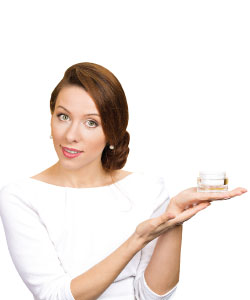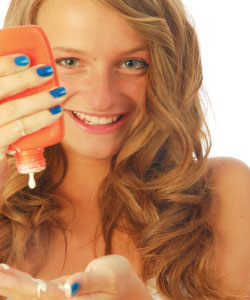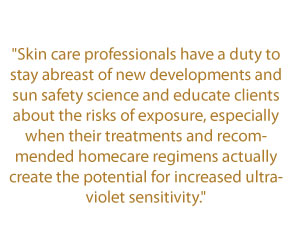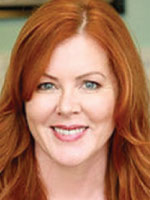By early summer, dehydration, redness, and more than a hint of the old hyperpigmentation is the new face of reality, again.
Fran is 40 years old and a former sun worshipper who has had amazing results repairing photodamage on her face. She is frustrated, however, because, at her budget's end, she cannot afford to add on treatments for her ultraviolet-damaged hands or décolleté.
Shelby is a 20-year-old college student who receives occasional miniature facials and regular bikini waxes. When her professional reminds her of the standard aftercare instructions, she laughs sheepishly, agrees to comply, and states that she has been tanning since junior high school.
Karen is the classic victim of at least three or more blistering, childhood sunburns from the 1970s and her décolleté is riddled with battle scars from the carcinomas she has had removed so far. She has a standing chemical peel appointment on a monthly basis and a follow-up appointment with her dermatologist every quarter.
These women represent a glimpse of today's clientele. Other familiar clients include the busy corporate traveler who will not wear sunscreen because her makeup has SPF, the runner or car commuter who should better understand reapplication, and the acne client who will not use any products out of fear of breaking out. Skin care professionals have probably treated them all.
The Professional's Duty
Here is the catch: Once the professional has actually met them, consulted with them, and treated them, they are then responsible for sharing important information about sun protection. Just one corrective facial treatment with today's innovations has the remarkable potential to do exactly what it claims. Treatment rooms are filled with products and technology claiming to repair, prevent, and protect from the dreaded photodamage. Skin care professionals have a duty to stay abreast of new developments and sun safety science and educate clients about the risks of exposure, especially when their treatments and recommended homecare regimens actually create the potential for increased ultraviolet sensitivity. As real photodamage repair becomes more attainable, the sun's damaging rays shine as bright as ever.
Every skin care line has at least one sunscreen product to offer clients. Professionals understand what they are selling and should be able to explain to their clients which product they should choose, why they should choose it, and how to use it. Oftentimes, however, professionals sell products to a compliant client who seems to easily understand the product has no questions. In this situation, can the professional be sure that all their bases are covered? Unless the client is purchasing all of their sunscreen products from the professional, they will have to make choices about sun safety that will impact the health of their skin. Unless a client truly understands the importance of why a particular product is being recommended, there is a good chance they will choose products based on a statistically-proven lack of understanding about sunscreen labels.
Sunscreen Misconceptions 
A study published in the New England Journal of Medicine in 2014 addressed the 2011 sunscreen-labeling changes implemented by the FDA: "In 2013 new labeling Investigators surveyed 114 patients aged 18 and older attending an academic medical center dermatology clinic in summer 2014 regarding sunscreen labels. Most responders did know which label items referred to UVA and to UVB protection. However, more than 40% indicated that their choice of sunscreen was driven primarily by high SPF, sensitive-skin formulation, and water or sweat resistance, and only about one third thought that use of a broad-spectrum sunscreen was important. A surprisingly small percentage understood that high SPF or broad-spectrum sunscreen protects against skin cancer (38%), that a broad-spectrum sunscreen is the most appropriate for preventing photoaging (7%), and that SPF value indicates the protective value against sunburn (23%)."
It has been repeatedly reported that most people do not understand that UVA damage is invisible (meaning that there is no sunburn or heat sensation). If a client uses sunscreen that is not broad spectrum, it is useless against these dangerous, penetrating rays. The FDA and other national organizations have launched photoprotection campaigns to help the public decipher the labeling system and the SPF code. Even so, when beauty blogs, magazine covers, and morning talk shows broadcast summer sun safety tips from April through August and aisles of colorful sunscreens blur the eye and numb the mind, how can skin care professionals break through the chatter to identify opportunities to help clients make informed choices for themselves and their families?
Building Trust
Trust between the professional and client starts with first impressions and is a bond that must be built, maintained, and nurtured. If the professional does not have the confidence of the client, they will not have her compliance. The following tips will help professionals to build trust.
Maintain a Professional Image and Workspace
Skin care professionals should portray themselves as the trained professional they are. Use appropriate gestures and eye contact and do not mispronounce words or speak over the client's head. It also helps to display magazines with supportive messages or reading materials from skin care lines or professional trade publications.
Practice What You Preach
The professional should keep their skin free from new ultraviolet damage; treat existing damage on their face, arms, and hands; and wear protective clothing and headgear, as well as sunglasses for protection.
Fulfill Professional Communication Obligations
Start and continue the communication process with a good consultation and evaluation that includes questions about sun exposure and past skin cancers. Present the client with clear recommendations for product use and treatments and clarify potential outcomes and expectations. Be sure to make sun protection behaviors a priority discussion with every service and sale and perform timely follow-ups. 
Seizing Opportunities
Clients who trust their skin care professional feel like the aesthetician is listening to them and relating to their wants and needs. Once the professional has established trust with first impressions, an active listening habit will help to maintain and grow that trust, resulting in the professional relating to the client. The following example demonstrates how actively listening and relating to the client strengthens trust.
During Megan's microdermabrasion treatment, she mentioned that her sister could not use sunscreen because it irritated her skin. The professional asked questions regarding the nature of her sister's reaction, the products used, and other things she may be allergic to. The professional also mentioned that she would like to help Megan's sister find a solution soon to help her avoid further ultraviolet damage. At checkout, the aesthetician revisited the sunscreen dilemma by suggesting Megan's sister come in for a free consultation. She also recommend a product with a higher mineral content and no fragrance, addressed how the new product should be used, and how it may look or feel different than what the sister is accustomed to. The professional also offered to follow up in a few days with a phone call or an e-mail to check on any potential reactions to the product.
Choosing to address Megan's passing comment about her sister by finding a solution demonstrates to Megan how important it is for her family members to wear sun protection. Trusted professionals have unique opportunities to influence their clients' sun safety habits. How can professionals recognize and take advantage of these opportunities without being pushy or seeming preachy? The following tips can be used in regular conversation during the course of a consultation, treatment, or checkout to influence and educate clients.
Family Protection
Clients purchasing sunscreen as part of their skin care regimen present a major opportunity for the expansion of all product sales to family members. By recommending they share a product with a partner or purchase a second bottle of sunscreen, professionals can move the conversation to a more personal level, potentially gain another client, and definitely earn another level of confidence.
For example, Sally mentioned that her husband is playing golf this weekend. This statement is a great opening to ask what type of sunscreen her husband uses on the golf course. Depending on the answer, the professional should recommend a purchase or sample to take home to him and include her with a card, in case he has any questions. Depending on where this conversation takes place, whether it is in the privacy of the treatment room or at the checkout station, further discussion of her family's sunscreen use may be an option. What do they use now? How do they apply it? Is there a history of skin cancer in her husband's family? When a client trusts their skin care professional, they are very open with this information, allowing the professional the opportunity for education. Once the questions about their sun safety habits have been asked, getting the right products and information in Sally's hands is the just thing to do for both her and her husband.
If child-safe sun protection is in stock, it will certainly boost loyalty points with parents when they are educated and understand that every kid-safe sunscreen is not necessarily safe. The Environmental Working Group and American Academy of Dermatology websites outline the appropriate and approved labeling for sunscreens. For example, as of 2013, there is no such thing as waterproof or sweatproof sunscreen, only water- or sweat-resistant. Labels should also specify the amount of time between applications, like 40 or 80 minutes. Furthermore, sunscreens only go to 50 SPF, but even those products are considered potentially unsafe because they may mislead consumers, especially parents, to think they offer substantially more protection than SPF 15 or 30. Other conversations should include avoiding controversial ingredients in kid-safe sunscreens and using safe-sun behaviors, like seeking shade and wearing loose clothing and hats.
Opportunities for short discussions with clients that are parents and/or grandparents with older children should address the fact that teenagers and college students are more likely to participate in sports with no sunscreen, use tanning beds, skip SPF under makeup, or go to the beach or lake after waxing or shaving, without applying sunscreen. Although the damage may not show up for years, professionals can prove that the damage from the unprotected exposure can be devastatingly real, deadly, disfiguring, and expensive.
For example, Pam mentions that she will be watching her 15-year-old granddaughter compete in a softball tournament next week. The completion of this statement is the perfect time to offer a sample facial cleanser, sweat-resistant sunscreen, and quick instructions that she should reapply the sunscreen several times throughout the day to avoid overexposure. As more than a feel-good gesture for the client, this recommendation is a great way to start a conversation about risky exposure among teenagers and young adults. Sharing quick facts and solutions regarding sun safety, along with a recommendation that she schedule a consultation for her granddaughter, will give the professional the opportunity to influence another generation.
 Promoting Regular Skin Exams
Promoting Regular Skin Exams
A career in skin care involves the observation of all sorts of conditions. Whether the professional works in a spa or medical environment, they will eventually see suspicious lesions that will lead them to recommend a visit to a dermatologist. There is no better validation of the professional's advice to use daily and appropriate sun protection than a medical skin examination. A dermatologist can be an aesthetician's best friend when it comes to encouraging a resistant client to use and reapply the highest SPF within reach. With the age of clients choosing to visit skin care professionals increasing, it is in the interest of their health to address regular, medical skin examinations on written or verbal consultations.
For example, Mary, who is 55, notes that she has never had a skin examination by her doctor. As a result, the professional should encourage her to have one as soon as possible. Although she is doing a great job caring for her skin, at her age, it is the perfect time for a dermatologist to take a look and map any moles or lesions that she may not be able to see on her back or scalp. Record that a skin examination was recommended and follow up with her about it at her next appointment.
Hair Removal and Cosmetic Services
Applying sun protection is a standard protocol after a facial treatment and is required by law in many states after exfoliation and laser services. Waxing and threading, however, typically have no SPF-application protocol. The exfoliation that occurs with waxing leaves the client far more vulnerable to ultraviolet damage than before the service. Applying sunscreen to the area after all other after-wax products have been applied should be part of every service. Not only is this application a safety issue, but it is also a way to promote new products and service sales. Because it has not been done traditionally, there is also an opportunity to discuss with loyal waxing clients that a new step is being added for their protection. With this conversation starter, professionals can easily move into a discussion about sun exposure, treatments, and more.
Furthermore, as tanning salons continue to see booming business, in spite of numerous links between skin cancer and tanning, it is the professional's responsibility to discuss tanning with clients. There is no such thing as a safe tan. Science has shown repeatedly that tanning is the result of ultraviolet damage and will, at minimum, ultimately cause signs of aging. At its worst, ultraviolet exposure will result in disfiguring and deadly skin cancers. JAMA Dermatology published results from a study in 2014 on the link between indoor tanning and skin cancer. The study found that in the United States, 35 percent of adults and 55 percent of college students have tanned and that there are more than 419,000 new skin cancer cases attributable to indoor tanning each year. Worldwide, there are more skin cancer cases due to indoor tanning than there are lung cancer cases due to smoking.
Although there are no definitive studies stating as much, removing intimate body hair before tanning areas that have otherwise never been exposed to ultraviolet rays is risky. Professionals should use this information to spark a conversation with clients and encourage them to make informed decisions.
Cosmetic Injections and Sunscreen
Like hair removal, there has been no universal protocol for applying sunscreen after cosmetic injections, although it is safe to gently apply sunscreen and makeup immediately after a treatment. The preparation for cosmetic injections is an alcohol preparation and, possibly, a topical numbing cream. Once all topical residue is removed and the bleeding has stopped, sunscreen can be applied. Due to the potential for scarring at the injection site, this treatment presents an important opportunity for broader education regarding sun safety and skin care.

Insufficiency of Spf
Environmental Working Group explains the outdated SPF on their website: "SPF stands for 'sun protection factor,' but that outdated term refers only to protection against UVB rays that burn the skin. It has little to do with a product's ability to protect skin from UVA rays, which penetrate deep into the body, accelerate skin aging, may suppress the immune system and may cause skin cancer. The worst thing about high-SPF products is that they give people a false sense of security and tempt them to stay in the sun too long. They suppress sunburns but raise the risk of other kinds of skin damage." 
This explanation is one of the easiest to understand and share with clients. The reality is that there is enough evidence showing the UVA-skin cancer link and that it is vitally important to educate clients about the confusing and often myth-ridden subject of SPF, ingredients, and labeling, as clearly as possible. The American Academy of Dermatology also has a straightforward label guide on their website.
Antioxidants
Whether it is an exclusive, patented molecule, a proprietary cocktail, or vitamins C and E, antioxidants are part of every quality skin care line. New studies have shown that antioxidants in the right formulation protect the skin against sunburn, sun tans and skin cancer and also reverse the mottled pigmentation and wrinkles of photoaging. The jury is still out as to whether adding antioxidants to a sunscreen is as effective, but layering them under sunscreen and using them at night are good practices to employ. Educating clients about the importance of multiple steps in their skin care regimen is a core part of the skin care professional's job. Understanding the science behind the steps, especially as it relates to sun safety and the risk associated with overexposure, can prevent the need to step back or start over well into the time when the client should have already seen results.
 Krissa Gordon, L.E., L.E.I. is the senior educator for Satin Smooth, a consultant, and a practicing aesthetician. Gordon, has counseled skin care professionals and students worldwide on technical, marketing, and interpersonal communication skills that build lasting client relationships and boost the bottom line. Personal experiences relating to skin cancer's devastating outcome among clients, family, and friends drives her passion to share sun protection education at every opportunity.
Krissa Gordon, L.E., L.E.I. is the senior educator for Satin Smooth, a consultant, and a practicing aesthetician. Gordon, has counseled skin care professionals and students worldwide on technical, marketing, and interpersonal communication skills that build lasting client relationships and boost the bottom line. Personal experiences relating to skin cancer's devastating outcome among clients, family, and friends drives her passion to share sun protection education at every opportunity.
